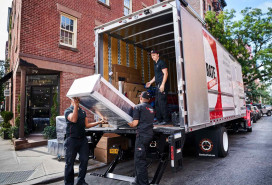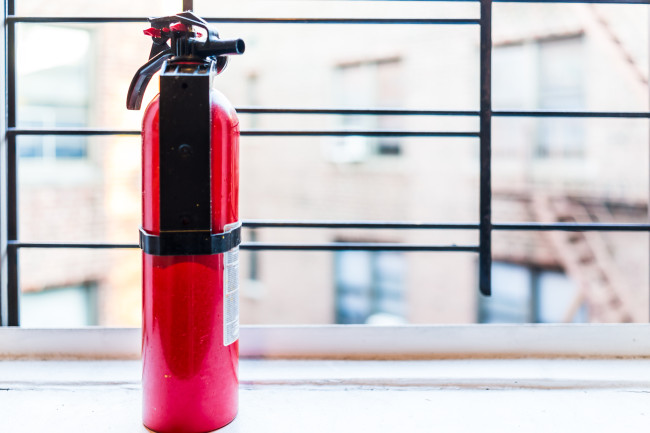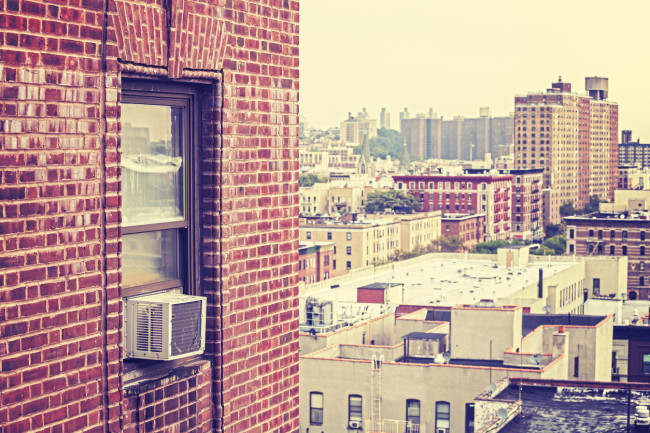Can you sit on a fire escape in NYC? 5 things to know
- Legally you can sit or stand on a fire escape, but FDNY doesn't want you out there
- FDNY’s safety guide says you should keep your fire escape clear of obstructions

According to DOB regulations, you cannot block fire escape windows or other exits with an AC unit.
iStock
Fire escapes are a quintessential part of the city’s landscape, long used by New Yorkers for hanging out, or a space to hang wet laundry, store bicycles, or grow plants, but there are few dos and don'ts you should know about.
First, here’s a little history on fire escapes in NYC: They were initially installed in buildings during the 1860s after several fatal tenement fires. After the horrific Triangle Shirtwaist Factory fire, the city tightened building codes, requiring fire escapes to be made from wrought iron and secured to buildings.
[Editor's note: A previous version of this article ran in August 2020. We are presenting it again with updated information for June 2025.]
Today, the Department of Buildings has multiple rules regarding fire escapes, including what they’re made of, how wide they are, and how they are attached. Your lease also might outline what you can and cannot do on your fire escape.
Here are five things you might not know about your NYC fire escape, including why you probably shouldn’t hang out there this summer.
It's not meant to be a balcony
Many New Yorkers treat their fire escape like a small balcony since private outdoor space is a luxury.
Legally, you can sit or stand on a fire escape, but you should think twice before you set up your home office out there. And the fire department doesn't want you or your stuff there either.
FDNY’s residential safety guide says you should keep your fire escape clear of obstructions at all times. Accidents do happen often: In 2020, a man who was thought to have gone out onto his fire escape for a smoke fell to his death.
Your AC unit can’t block access
Let's say that like a lot of New Yorkers, you rely on a window AC to stay cool. If your bedroom has a single window, and that window leads to a fire escape, it can be a little tricky.
According to DOB regulations, you cannot block fire escape windows or other exits with an AC unit. Your lease likely reinforces this rule too. One solution: A portable air conditioner.
It’s illegal to store stuff out there
Space is limited in NYC apartments so it can be tempting to put your stuff on the fire escape, but rules on this are clear: Your fire escape must remain empty (it is intended as a fire exit after all).
DOB says it is illegal to block a fire escape with items. Have a neighbor who is using their fire escape as a storage closet? You can call or go online to 311.
They get check ups
Fire escapes are covered by Local Law 11, also known as the Facade Inspection & Safety Program, so if your building is six stories or higher, your landlord is required to have your fire escape checked out every five years.
If you’re unsure of how safe your fire escape is, here is a very lengthy list of rules from the DOB for fire escapes. Importantly, they should have ladders that reach the ground. And if your fire escape isn’t fully attached to the building, it's not safe.
You won’t see them on new buildings
Fire escapes are not installed on new residential buildings, thanks to a 1968 building code change. Instead, buildings must have internal stairwells and an alarm or sprinkler systems.
Buildings built before 1968 can have their fire escapes removed, but your landlord has to prove that there is another way to exit the building in an emergency.
—Earlier versions of this article contained reporting and writing by Austin Havens-Bowen. This article was updated for 2025 by Jennifer White Karp.
You Might Also Like






























